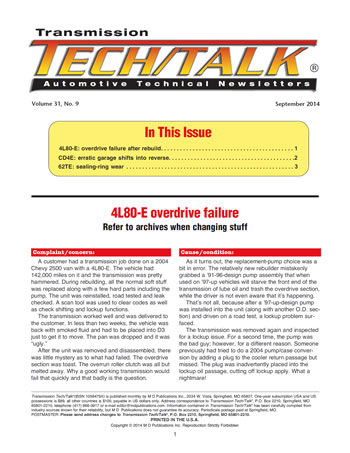



A customer had a transmission job done on a 2004 Chevy 2500 van with a 4L80-E. The vehicle had 142,000 miles on it and the transmission was pretty hammered. During rebuilding, all the normal soft stuff was replaced along with a few hard parts including the pump. The unit was reinstalled, road tested and leak checked. A scan tool was used to clear codes as well as check shifting and lockup functions.
The transmission worked well and was delivered to the customer. In less than two weeks, the vehicle was back with smoked fluid and had to be placed into D3 just to get it to move. The pan was dropped and it was “ugly.”
After the unit was removed and disassembled, there was little mystery as to what had failed. The overdrive section was toast. The overrun roller clutch was all but melted away. Why a good working transmission would fail that quickly and that badly is the question.

As it turns out, the replacement-pump choice was a bit in error. The relatively new rebuilder mistakenly grabbed a ʼ91-96-design pump assembly that when used on ʼ97-up vehicles will starve the front end of the transmission of lube oil and trash the overdrive section, while the driver is not even aware that itʼs happening.
Thatʼs not all, because after a ʼ97-up-design pump was installed into the unit (along with another O.D. section) and driven on a road test, a lockup problem surfaced.
The transmission was removed again and inspected for a lockup issue. For a second time, the pump was the bad guy; however, for a different reason. Someone previously had tried to do a 2004 pump/case conversion by adding a plug to the cooler return passage but missed. The plug was inadvertently placed into the lockup oil passage, cutting off lockup apply. What a nightmare!

All this could have been avoided by following the adage “Look before you leap.” There have been several articles written over the years concerning 4L80-E changes, including the pump and case. Key points of identification can, however, be broken down into a few basic categories.
Case Differences
Starting with the case differences, there have been some subtle changes over the years; however, three basic designs affect cooling and lube.
1. 1991-1996:
When the 4L80-E was first released, in 1991, both cooler lines were at the front of the case, almost side by side, as with most GM transmissions (Figure 1). Apparently sufficient lube flow was not getting to the back of the transmission under all conditions, so something needed to be done.
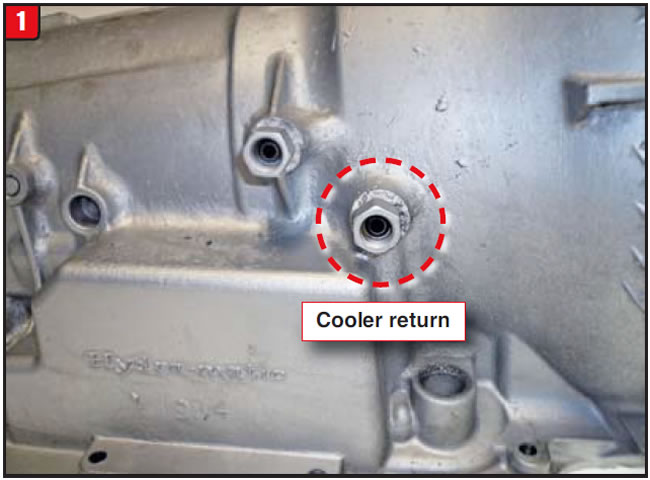
2. 1997-2003:
In 1997, big changes occurred affecting a bunch of stuff, beginning with the case. The return cooler line was moved toward the center of the case with the cooler fitting extending into a center-support seal (Figure 2). This design provided better cooler flow to the rear gear train, leaving the front end getting lube via the pump. Although the cooler fitting was moved, the boss remained, unmachined. The design of the internal lube tube also changed. The key issue is not the outside of the case, but rather the inside.
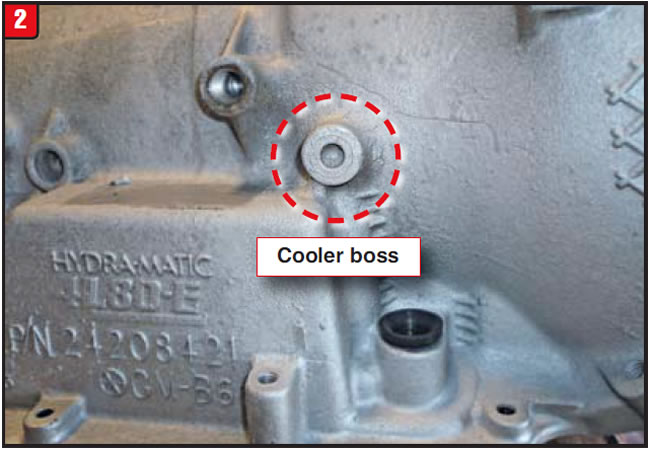
The cooler-fitting hole extended through the case to connect with the cooler return passage in the pump (Figure 3). The 1997 revision resulted in this hole being blocked (not drilled through). The case remained this way until 2004.
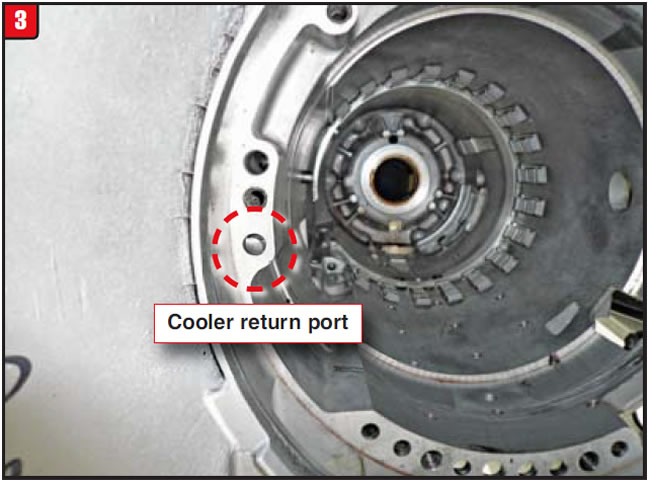
3. 2004-up:
For some reason, in the closing days of the 4L80-E transmission, GM decided to make more changes affecting the case. The boss for the cooler-return fitting was totally removed from the side of the case (maybe to reduce weight) (Figure 4). If thatʼs all there was to it, no big thing, but of course, such was not the case.
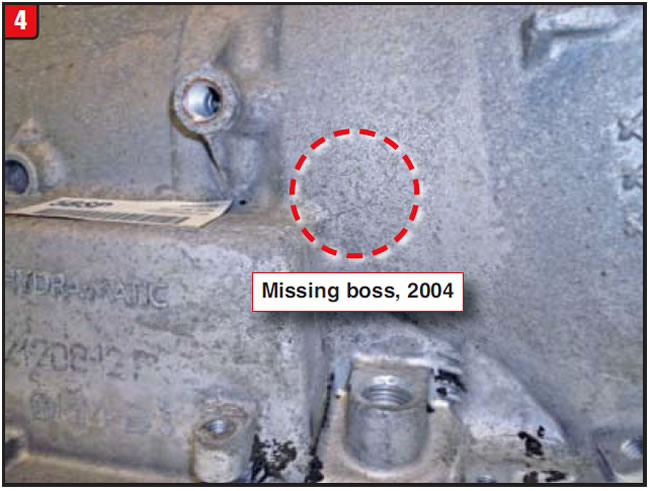
When the cooler boss was removed from the outside of the case, the corresponding hole inside at the pump gasket surface was also removed (Figure 5). Normally, removing a hole in a case would not be a problem, but in this instance the corresponding hole in the pump cover was exposed and would dump lube oil for the front end. GM actually had this problem during the 2004 changeover and had to come up with a quick fix to avoid meltdowns.
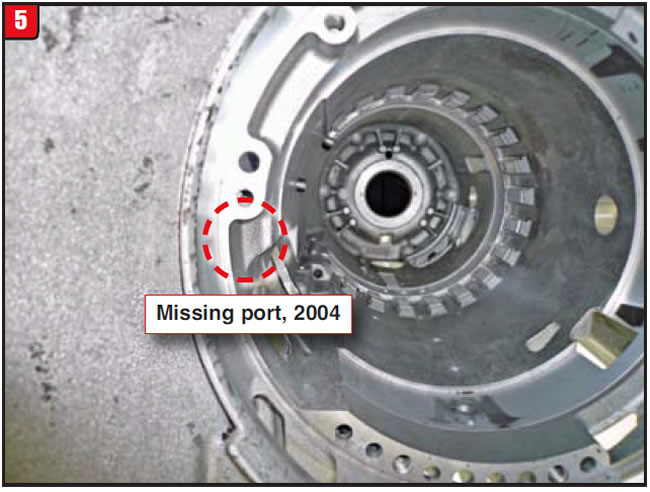
The next item to focus on is the pump body.
Although there were also a couple of minor changes, the main ones again have to do with the cooler circuit. Casting numbers have also changed accordingly.
1. 1991-1996:
The pump body released in 1991 had a casting number 8678778. Other numbers were also used; however, the main area to focus on relates to the cooler-flow passages (Figure 6). The worm track that is circled is the key. The ʼ91-96 pump body must be used with the ʼ91-96 case and ʼ91-96 pump cover. In addition, the pump bushing used was a narrow design.
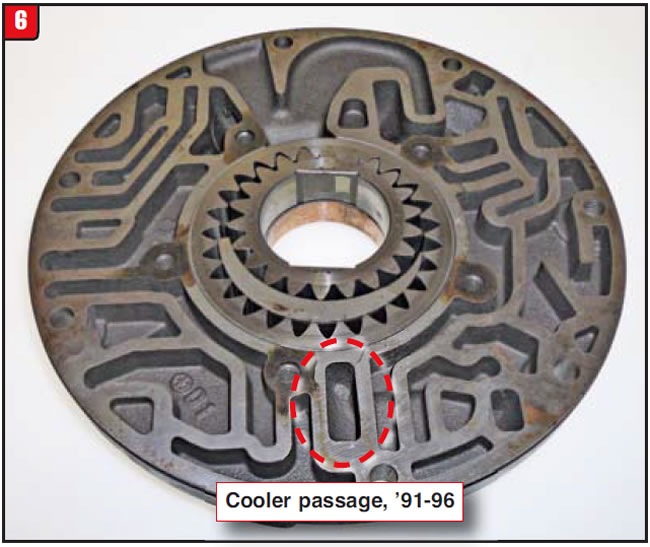
2. 1997-up:
The ʼ97-up pump body was modified to work with the ʼ97-up cooler/lube redesign. A bridge was added to the cooler passage, which can be compared with the passage on the ʼ91-96 type (Figure 7). The upside is that the ʼ97-up design will retro to 1991 so consider it ʼ91-up. The casting number changed to 24205779 initially. The pump bushing was increased in width as well.
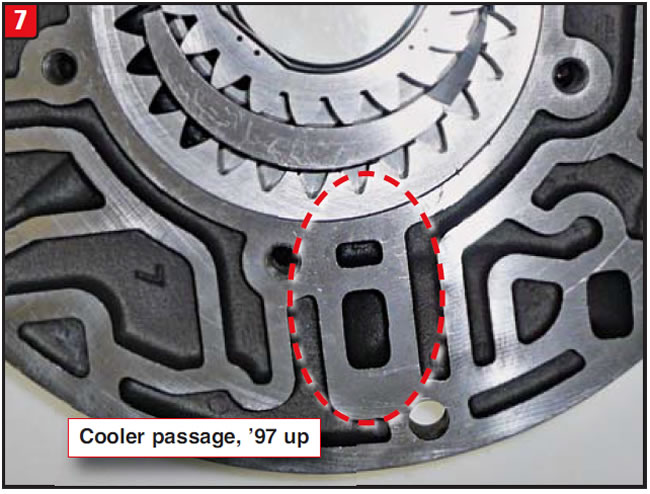
The last item affecting the trio is the pump cover.
It is imperative to match the case, pump body and pump cover to avoid problems. Since the 4L80-E spans a decade and a half, losing track of info is not that difficult.
1. 1991-1996:
The first pump cover, released in 1991, had a problem beyond the cooler issue that involved the transmission vent. Fluid would burp out at times due to the worm-track design. Almost immediately the cover was modified to accept a vent plug at one bolt hole, so do not use the ʼ91-design casting number 8678779. The main focus is the cooler worm track, which is rectangular above the TCC valve (Figure 8). This cover design can work with only a ʼ91-96 case (front cooler lines). The cover requires cooler flow from the radiator, which is blocked on ʼ97-up cases. The modified cover casting number is 24202263.
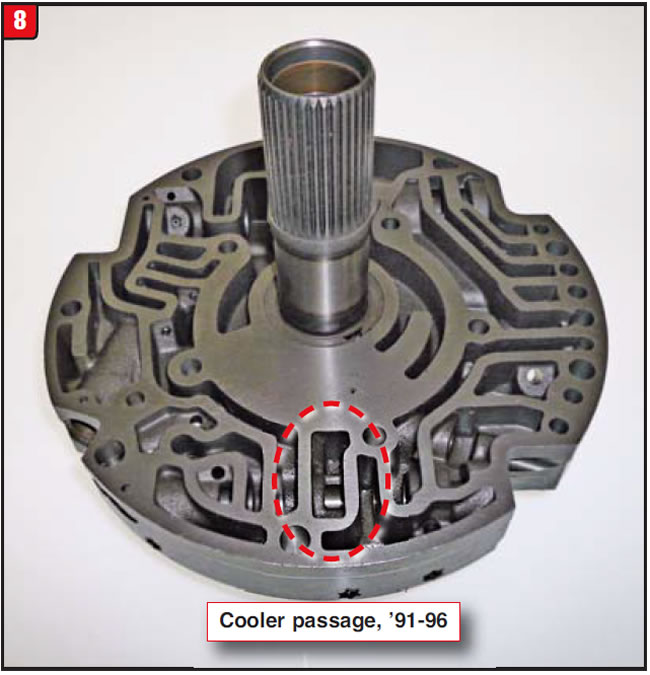
2. 1997-2003:
When the cooler return line was moved to the center-support area, the pump cover was modified along with the body to redirect front lube oil. A bridge was added to the cover (as with the body) fluid cavity along with an orificed notch (Figure 9). Front-end lube was then completely internal. Limit this design to ʼ97-up cases. Casting numbers include 24203512 and 24221379.
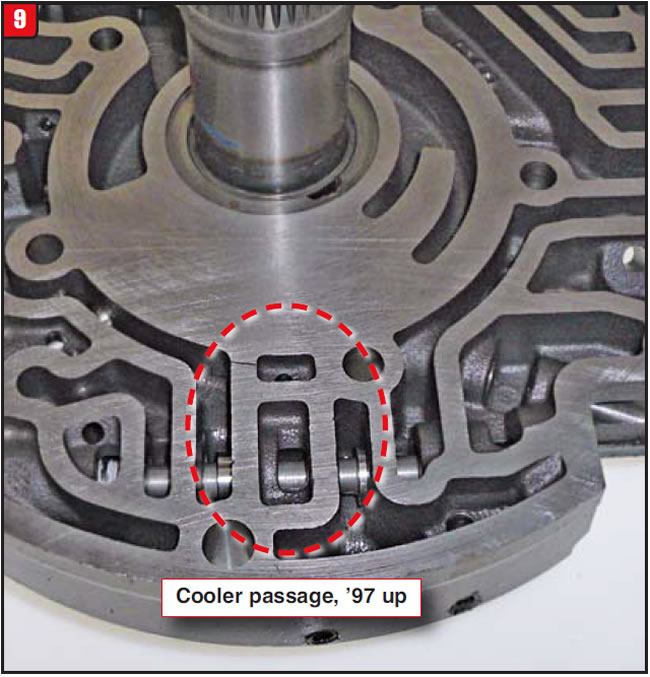
3. 2004-up:
In 2004, when GM modified the case affecting the return cooler passage, the pump cover needed tweaked as well. Unfortunately, the case-casting change got ahead of the pump-cover change and problems arose. As a fix, GM released a cover package to work on ʼ97-up models. The fix involved plugging the cooler return hole (Figure 10). When the ʼ97-design cover is used with the 2004-up case (with-out the cooler boss), the cover hole must be plugged. Merely knock out the small cup plug from the cooler return hole, insert the pin and stake it in place like the original cup plug. This will prevent lube oil from dumping out. Ultimately, GM cast shut the hole in the cover.
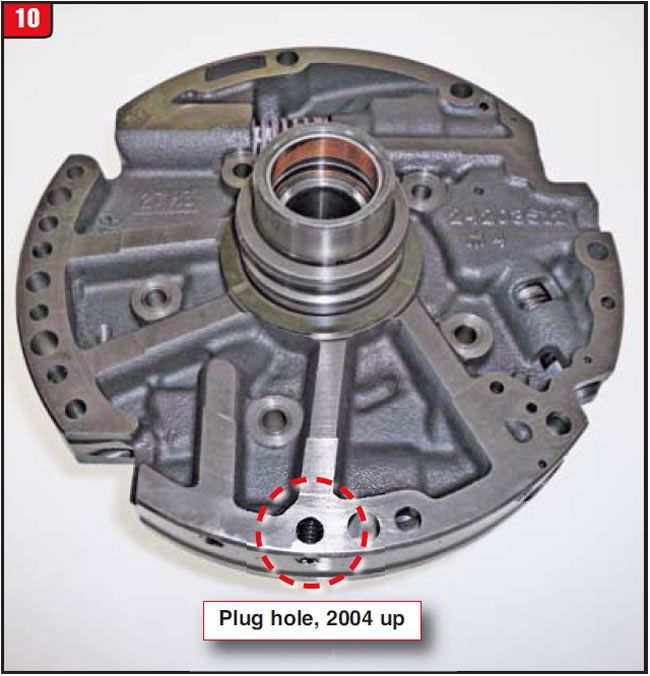
4.
If needed, the pin can be purchased separately for cover conversion, under part number 24232339 (Figure 11).
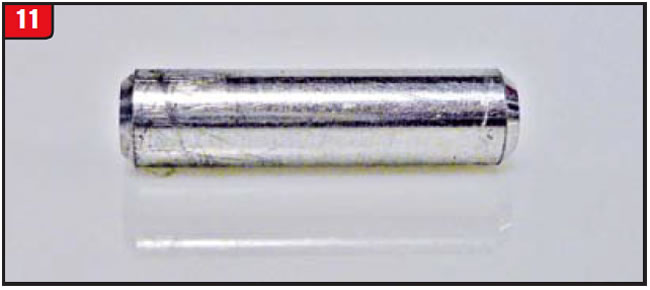
Old news applies, even for something that occurs today. Make sure itʼs handy.




A 2002 Ford Escape was experiencing erratic garage shifts into reverse. The vehicle had a CD4E transmission and 3.0L engine. Although it had 176,000 miles on it, the transmission worked fairly well – with the exception of the reverse problem, of course. In addition, a check engine light would surface occasionally. A scan tool was connected to pull any codes. Two codes were found in the history, P0708 and P1702, both of which relate to the TRS (transmission range sensor).

Common sense dictates taking the path of least resistance, so the TRS was checked out first and was found to be bad. The erratic condition was due to terminal corrosion, which can make or break any electrical connection, as was the case for the Escape.

The question comes into play as to how the TRS could affect garage shifts, drive and reverse differently. The CD4E TRS is like several other Ford-type range sensors (Figure 12). It is an adjustable type with a single harness plug.
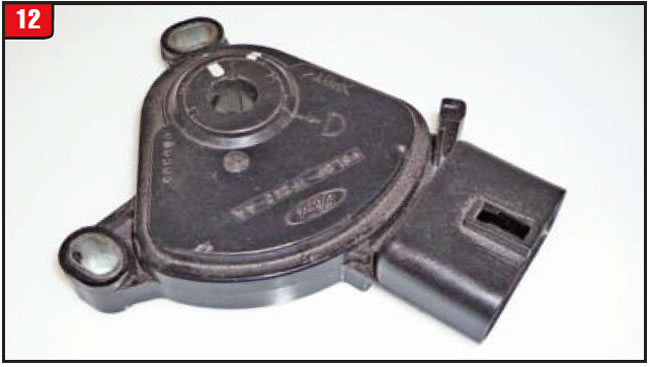
There are 11 flat-blade terminals that provide electrical signals through the external harness to the PCM etc., all of which must make a good connection (Figure 13). When corrosion takes over, all kinds of things can happen, and not consistently. Depending on which terminal is affected, different symptoms occur.

The Escape TRS was in pretty bad shape and should have caused many more problems than just erratic no reverse (Figure 14). The external harness plug was not in too good a shape either and needed to be replaced.

When it comes to initial shifts from Park to reverse or Park to drive, many transmissions feed the apply components directly from the manual valve. That means regardless of external electrical conditions, garage shifts are always possible. With other transmission types, such as the CD4E, that is not the case.
When a CD4E manual valve is moved to drive, oil pressure passes through directly from the valve to the forward clutch and accumulator, which results in first gear. Solenoid number one (SS1) has the 1-2 shift valve stroked to the right to prevent second gear (Figure 15).
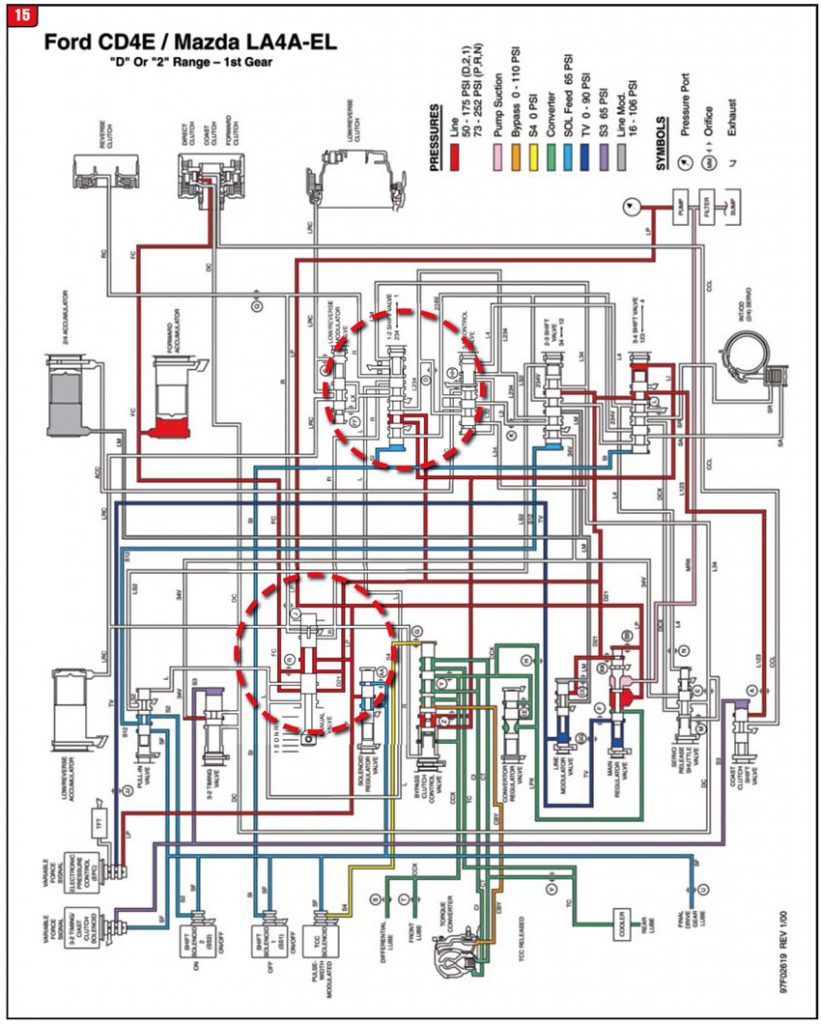
When a CD4E manual valve is moved to reverse, oil pressure passes through the valve, but with a different effect. From the manual valve, oil pressure passes through different passages of the 1-2 shift valve (than it does in drive) and goes to the reverse clutch. Pressure is also directed to the low/reverse clutch through the low/reverse modulator valve as well as the low/reverse accumulator (Figure 16).
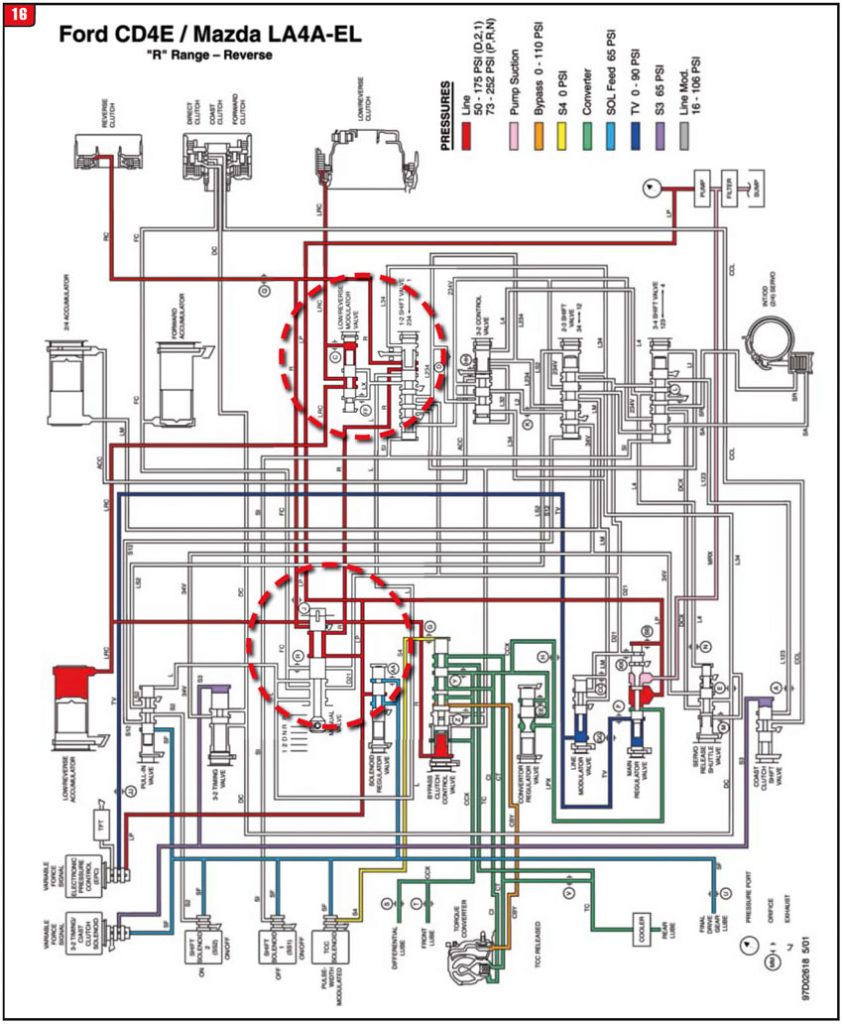
If for some reason the 1-2 shift valve would be stroked to the right, as it is in drive (first gear), the reverse oil passage is then blocked. In addition, the reverse oil passage downstream from the 1-2 shift valve would be opened to exhaust, ultimately preventing reverse. This is how the incorrect TRS signal would impact reverse, but not in drive.
The 1-2 shift-valve arrangement provides the ability to act as a reverse blocker while the vehicle is moving forward.
Finding and fixing the faulty TRS prevented removing the transmission without cause and gained a loyal customer. It pays to “always check the little things.”



Chrysler released the 62TE in 2006 for limited applications but has been expanding model usage ever since.
Basically, the 62TE is a modified 41TE (A604), and the two actually share many common parts. Although there are components that are identical, a few are close but no cigar, such as the rear-planet carrier. On the surface, the two planets look the same; however, the park-gear tooth counts are different and the wrong one has been installed in the past. Use caution when interchanging anything.
Upgrading from a four-speed to a six-speed certainly affected the controls, such as the valve body and electrical components. The 62TE definitely has more stuff. The main item that was added to make a six-speed was the compounder unit, which is merely Chryslerʼs name for an underdrive section. As with other transmission types that have undergone the same design changes, a compounder section consists of a planetary set and a couple of separate clutch packs. As a unit, the compounder ultimately drives the transfer gear in either low (reduction) or direct drive. There is also a one-way clutch (OWC) to help in the transition from one gear to the next.
The two clutch packs that comprise the compounder unit are the low clutch, which is the stationary “brake,” and the direct clutch, which is a rotating clutch. Getting the compounder unit out of the case can be a bit of a chore, so follow recommended procedures.
Vehicles with a 62TE are now showing up for repair more frequently and for different reasons. One reason that really stands out has to do with the compounder low-clutch assembly. Vehicle symptoms may indicate a low-clutch issue or there may be other symptoms beyond a bad clutch. Regardless, close inspection is required upon disassembly. The low-clutch wear issue actually impacts direct-clutch apply, not the low brake. Symptoms can arise anytime the direct clutch applies.
The direct-clutch sealing rings are on the low-clutch housing (Figure 17). The low-clutch housing is aluminum, including the sealing-ring grooves. The sealing rings are a plastic material like Vespel or Peak. Over a certain number of miles, sealing rings start to wear the side wall of the ring groove, in some instances causing substantial wear. The bore of the direct drum is steel and very seldom wears.
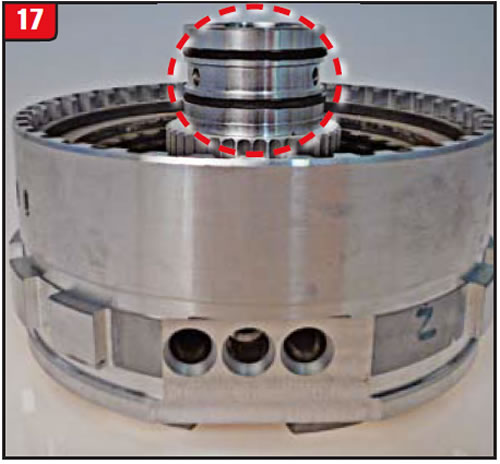
What other manufacturers have learned over decades is that regardless of sealing-ring material, aluminum sealing-ring grooves or aluminum sealing-ring bores “ainʼt makinʼ it.” Wear is inevitable.
Due to failure rates, Chrysler has now modified the low-clutch housing to prevent ring wear. The company copied a GM feature by notching the ring grooves and adding a tang to the sealing rings, like on a 4T60-E second-clutch housing (Figure 18). The new clutch-housing part number is 68029389AC. The housing comes loaded and is not cheap.
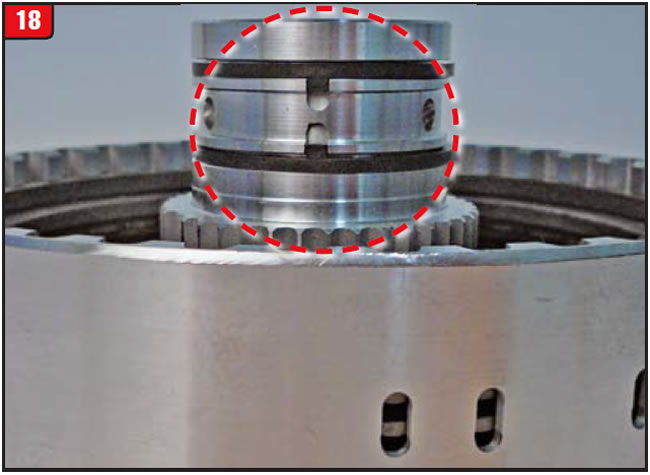
Another option is going reman. WIT (Whatever it Takes) now offers a remanufactured housing that has a steel sleeve with ring grooves cut into it to prevent wear.
When a 62TE is rebuilt, the housing should be replaced, regardless of wear, and “take a lesson from others.”


September 2014 Issue
Volume 31, No. 9
- 4L80-E: overdrive failure after rebuild
- CD4E: erratic garage shifts into reverse
- 62TE: sealing-ring wear

